Introduction
The Industry of Vision project (IV) and the conjoint exhibition took place from primo 2000 until ultimo 2001.The project generated models of co-creating processes and internal communication within the production facilities of the two Danish manufacturing companies Basta Ltd. and LK Ltd with participation of the artists and artists’ groups Joachim Hamou, N55, SUPERFLEX and my self, Kent Hansen – in the trajectory my ongoing “art firm” democratic innovation. The project and exhibition was initiated by democratic innovation and further developed and organized in co-operation with the working life consultancy ‘BST Soroe’,[1] The Danish Institute of Technology (DTI), and - in relation to the conjoint exhibition, with ‘West Zealand Museum of Fine Art’, Soroe.
[1] Footnote - “BST Sorø” - a regional BST (The Employees' Health Service) - in the County of West Zealand. BST were at that time a national wide, with regional offices, semi-official consultancy on working life, health and environmental issues.
The following account of the project and exhibition is based on an evaluating memorandum based on a series of qualitative interviews with the different participants (Teknologisk Institut, BST Sørø, demokratisk innovation, 2001), an interview with the two participating consultants (Gitte Holm, DTI and Pernille Forchhammer, BST) independently executed by work psychologist Pia Damgaard Andersen,[2] and from on-site observation hold together with these accounts. Some brief documentation of the Industry of Vision exhibition follows this account as the exhibition was part of the overall processes of the project.
[2] Footnote - Parts of this interview is published in: Visionsindustri, Buhl Andersen & Hansen, Copenhagen 2001.
Concept and realisation
IV began with a shared interest in the concept of work and ‘organising’ and the consequences of such concepts. The project evolved during conversations that between working life consultant Gitte Holm, DTI and my self/democratic innovation. These conversations date back to 1998 in connection to the art project and exhibition Roomservice, which I organised 1998-99 concerning a development scheme of the harbour area in the city of Ellsinore. The focal point of ‘Roomservice’ was to investigate how artists view the subject of ‘organising’ and organisation of work. At its outset IV then emerged both as part of the practice and interests of ‘democratic innovation’ of process-based (visual) art in the field of ‘organisation’ and ‘work’ and of Gitte Holms professional interest in the possibility of art in a mediation of specific problematic of working life and organisational issues to the public.
The later project description said:
"The conclusion of previous projects (by TI/BST) shows (…), that it is difficult to go beyond routines and untenable habits and concepts at the workplace, and hard to find new ground and conduct in the development of work.
(…)
The idea of Industry of vision is to integrate the particular language of the artists in the creation of a ‘space’ for communication and development at the companies; A space that suspends the existing customs regarding internal communication, and that make it possible to challenge the firm stances towards daily work. In the course of project art concepts and products are to be developed in interactions and dialogue between miscellaneous agents; art professionals and non-art professionals (…)
Industry of Vision explicitly engages art in a democratisation of work organisation at the individual companies”
The initial concept development now became more of a preparatory process, and eventually IV became now coupled with the project “An undertaking against EGA – a regional project in the County of West Zealand"[3] for which Gitte Holm was the project coordinator. This coupling primed the financial base for the project. The financing was later on secured by support from the Danish Arts Counsel, the former ‘Danish Contemporary Art Foundation’, the regional Trade Union, and, most substantially, from The Confederation of Trade Unions Denmark. The later co-operating manufacturing companies co-financed their part of the project through the labour put into the project and through their membership of ‘BST Soroe’.[4]
[3] Footnote - Between 1998-2001, throughout the project “An undertaking against EGA – a regional project in the County of West Zealand” – BST Soroe and Institute of Technology worked with different methods to reduce EGA - Ensidigt Gentaget Arbejde, which means: over-specialised repetitive and monotonous labour. The regional ‘EGA-project’ was part of a national wide undertaking against this kind of ‘EGA-work’. (On “BST”; see note 1).
[4] Footnote - By Danish legislation al industries of a certain size were at that time to be member of such regional BST. The industries partly finance the activity of the BSTs.
Early in the spring of 2000 artists and artists’ groups N55, SUPERFLEX and Joachim Hamou began to take part in the preliminary discussions and eventually agreed to participate. At this stage two manufacturing companies ‘Basta’ in Korsør and ‘LK’ in Ringsted as well agreed to participate. ‘West Zealand Museum of Fine Art’, the main art museum of the County of West Zealand were the EGA-project took place, had been contacted in the very beginning of project development. The participation of a regional based museum was to emphasize the regional interests and aspects of VI. With the museum as a public venue the changing role of the art institution - when the more process based art emerges – as well were accentuated.
Interests and roles
EGA-project
The two specific companies Basta and LK were contacted primary because they had participated in some previous attempts in the before mentioned ‘EGA-project’. The objective of ’EGA-projects’ was to bring into focus the traditional organisation of work and technology. The traditional approach to organise work often result in a monotonous and repetitive labour. The conception is that such very organisation of work is rational and efficient. For the employee the consequences are poor health and a tedious working life. For the employer the consequences are an inflexible and often inefficient work force, because the employees do not thrive.
Basta
In the Case of BASTA it was a clear objective to bring about the consequences of its traditional organisation of work and technology. The production workers were reluctant to change their monotonous work processes. Moreover the company had undergone a torrent of alternations in the top management; in general the personnel were in low spirit.
LK
In the case of LK it was also an objective to go further than to bring ‘EGA’ into focus. The company had already established a number of self-governed production teams that to some extend minimise EGA. LK now wanted further inspiration and to focus on the knowledge exchange between and establish a sharing of ‘best practises’ among the self-governed production teams. The knowledge exchange was hard to come about, probably because the organisation at present time just had merged two smaller and disparate production facilities into one larger facility.
Art and consulting
IV was as a general set-up a partnership between the art initiative democratic innovation and the EGA-project. The principle of the project was an even balance between the art-part and the consultant-part in the project. To ensure the secure of this balance, the general project management of IV was split between ‘art’ and ‘consulting’. Gitte Holm was to manage the coordination between the interest of ‘EGA-project’ and interest of IV. And she also was to manage the general budget. Gitte Holm and Pernille Forchhammer functioned together as observers, sparring partners, advisors to the project. As ’art director’ I was responsible for the curating, the matchmaking between the other participating artists and the companies - and for the managing and coordination of the course of project according to the mandatory resources. I and the other artists played out the joint course of action together, and throughout the project the two consultants and I stood in continuous contact. We evaluated what happened at the individual company, paying attention to and discuss various emerging problematic. According to circumstances I discuss the various situations and processes with the other artists. Moreover I represented the other artists in relation to the steering group of the project.
Steering group
The main function of the steering group was to be an ‘external space’ - formatted by its members. Establishing such ‘external space’ meant that both managers and employees met the other ‘external’ members and each other in a other context than the usual, and participating in a more deferential setting and discuss in a more general manner; other perspectives could be attained in such group. Furthermore the companies couldn’t that easily redraw from the project, because more were at stake when crucial stake-holders were represented in the project. The members of the steering group were representatives from: top-management of BASTA korsoer (the CEO); employees of BASTA Korsøe, top-management of LK Ringsted, employees of LK Ringsted, DTI (Gitte Holm), BST Soroe (Pernille Forchhammer), LO Vestsjaeland - the regional trade union (chairman of trade union), The Confederation of Trade Unions Denmark, The County of West Zeeland (the cultural director); West Zeeland Museum of Fine Art (the assistant director), and I/ democratic innovation.
The artists
All the participating artists had all until that time worked with more or less interactive dialogical processes within existing social and cultural infrastructures as part of their artistic practice. However, the artists’ approach in projects and exhibitions takes various departures. The concept of the project therefore was worked out in a way that the starting point of the art processes at the single company had the possibility to be in the scope of the professional approaches of the individual artists and artists’ groups’. I will therefore lay out the participation artists’ various focuses:
SUPERFLEX
SUPERFLEX (Copenhagen) provides ‘tools’ that are based on their specific interest in social and economic commitment. The tool-set-ups are developed in co-operation with diverse experts who, in turn, add their own specific interests. It can then be taken over and put into operation by various users. The tools invite people to become active. Tools are framed by and shaped in specific social and local situations and generate their meanings out of this specific context.
N55
N55 (Copenhagen) states that ideologies, religions, subjective opinions, social conventions, and habitual conceptions do not necessarily respect conditions for description and representation. N55 approach is to find possible ways of an existence with minimum of power concentrations. From the upstart of IV the artist of N55 made it clear that they entered IV with a critical attitude towards "a marriage" between artists and corporations.
Joachim HamouFilm director and artist Joachim Hamou (Copenhagen) work with different formats and genres of the film media and video, though his work evolves in a perspective of visual art. Joachim Hamou especially investigates the relations between reality, documentation and fiction; what come about when human pursuits of an identity are played out in a semi-documentary/fictional framing?
www.n55.dkdemocratic innovation
democratic innovation (Copenhagen) is ad-hoc initiating and organising projects that are merging into structures of organisations and institutions through the practical course of events, mixing various artistic and aesthetic strategies. democratic innovation functions by virtue of, and together with, the participating partners.
www.demokratisk-innovation.dk
Back to Square Zerro
In the initial stages I had represented all the other artists in relation to the EGA-project . The other artist could influence the general project development through ongoing discussions with me. Nevertheless it was the consultants and I who established the very conditions for the project; a framing of the project was significant in gaining the acceptance of the companies. We had generated a general project design which of course could potentially fixate a course of action and as well couldn’t – naturally - to the full tackle the individual artistic future approaches in the project. The general project design was now informally re-conceptualised at a joint meeting. We agreed upon a kind of a ‘zero state’ of the project, and the initial project idea of a tryout of various artistic approaches and facilitating roles in the contexts of commercial companies was enforced.
Later on we learned that the handing over of the facilitating roles onsite at the companies could have been more explicated. The consequence was that the ‘authority’ for a while hovered in-between the artists and the consultants; the managers and employees had at first a hard time in conceiving that the otherwise consultants ‘traditional’ facilitating role now were held by the artists. Moreover the consultants easily fell into their familiar role when addressed by the managers and employees. Subsequently, as ‘art director’ - I at times had to stress the general idea of trying the artists’ way of facilitating or ‘making possible’ an artistic co-creating development process.
at LK
At the LK factory the project was established as a collaborative effort between employees, managers and artists (SUPERFLEX, Joachim Hamou and Kent Hansen). Representatives from 13 self-governing production groups (the total of production groups at the factory) and two members of the LK project management group (a intermediate manager and a project/personnel manager) were involved in this pilot project at LK.
A start up workshop was a mix of group processes, e.g. usage of snap shoot cameras in the pursuit of possibilities and impossibilities of the individual work spaces, and plenum discussions with an overarching question: ”Why Should We Speak to One Another”. To frame the processes at LK the title “SUPERKONTAT” was chosen.
The different modes of dialogue, discussions on needs of communication, of different habits and the many emerging different ideas, suggestions, etc., throughout the project uncovered a considerable urge for the strengthening of informal communication at LK factory. The ultimate proposal that was developed contained the meeting space, a pc-station for local radio ‘board’-casting, a bulletin board, a devise for anonymous collection of ideas, et. al. The ‘broadcasting’ was designed to be distributed through the factory Intranet; all employees should be able to listen to e.g. favourite music and radio productions of employees as well as formal bulletins from the management.
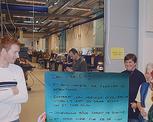
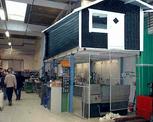 Working on the proposals // A digital animated proposal for the placement and the design – a traditional holiday cottage - for the space “The Wise Oak”.
Working on the proposals // A digital animated proposal for the placement and the design – a traditional holiday cottage - for the space “The Wise Oak”.
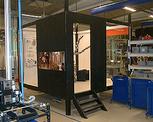
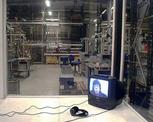 The realised ‘Wise Oak’ in the factory space
The realised ‘Wise Oak’ in the factory space
– with various communicative elements, billboard, the radio station, display of future radio programmes and other various proposals for future projects, and display of the project documentation: videos, images, texts.
The radio station at the Wise Oak’, and ‘The Wise Oak’ (installation made of ‘failed products’ and branch of a tree) // The programmes were to be distributed to the employees by wireless headphones and the work groups Pc stations.
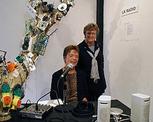 The ‘broadcast’ of a radio program. Detail of ‘The Wise Oak’-installation.
The ‘broadcast’ of a radio program. Detail of ‘The Wise Oak’-installation.
This ‘final’ concept integrated almost all the ideas and demands expressed at the meetings and workshops. The concepts ambition was to strengthen and mix the informal, spontaneous and uncontrollable communication with the formal, planned and systematic communication.
The executives expressed the great potential of the project regarding communication, culture and cooperation throughout the firm, and wanted to go further by involving the HRM department in the prospects. At this point a continuation was out of the hands of the IV-project, and to my knowledge the developed ideas and general concept were shelved later on. Still, at this point, an actual implementation of the general proposal would have resulted in astonishing changes and would have had vast implications. In any case: The project created indisputable experiences especially among the participating employees and managers, and was part of the corporate storytelling in the years that followed; and maybe especially part of the informal corporate storytelling.
Processes and facilitation at LK
The approach at LK was somewhat abstract. We talked and worked with visions, communication and overarching systems. Continually a reflection on the work life, organising and the actual group process was facilitated. This dialogical process caught on among some employees, though the abstract approach had difficulties in engaging all participating employees. The fact that the involved representative of the top managerial group was less supportive in the actual process didn’t help; worries on budgets, in phases when creative processes were the primary, didn’t help either. Some employees had therefore a hard time of legitimising the spending of fellow resources when facing their colleagues in the self-governed productions groups.
LK Ltd. (Ringsted Denmark, 2001)
- is a modern company focused on technology and market development. They develop; produce and market complete solutions for electrical installations and focus on four main areas: traditional electric appliances, intelligent installations, data and communication as well as lighting. LK Ringsted employed at that time around 350 people.
at Basta
Initial meetings were held, but as a first initiative the system PUBLIC THINGS, developed by N55, was built as an installation at the Basta premises in a room made available for the project. "Public Things" at Basta fit out as a permanent ‘free zone’ for the employees and managers to enter, with a mattress for relaxing and listening to music, and with a computer and open internet-access available.
Space with PUBLIC THINGS at the factory; with Internet access, billboard, madras, and more – all for the use in the work hours.
A thematic seminar was planed. At the particular day all production was shut down and administrative functions were left to a stand hold. First and foremost the day was planed for the formation of a number of groups that should work on specific tasks. It was up to the staff to propose and select the tasks to work with. There were a plenum presentation and debate, and soon 5 of tasks were concluded. The design processes kicked off and the production workers, the administrative staff, the product designers and the mangers sat around in groups discussing and sketching on the different ideas and tasks, which became:
• Collective cooking-sessions
One group arranged a collective cooking and eating sessions at that day. Such sessions should continue throughout the project in turns/in rotation.
• A flower garden with fireplace
One group were to design a flower garden with a permanent outdoor fireplace at one of the lawns at the premises of Basta, Korsoer
Design of a garden at the Basta premises – with flowers, bushes, herbary and fireplace with a grill.
• An employee website
One group were to design and implement a public corporate website but solely for propose of the employee and their specific interests. This site should function as a blog during the project.
Computer workshop - working on the employees website.
• ‘The Anarchists’ Project’.
This project scheme was an ‘self-documentation’ e.g. video interviews of fellow employees, mainly facilitated by Frank, one of the workers at Basta. Frank is an amateur photographer.
• A communal bicycle, for 30 people
Yet another group were to design and produce a bicycle in sections and link in a way it could be driven by 30 persons. This bicycle was to be used on two annual public events at which the joint Basta personnel used to participate.
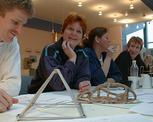
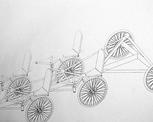 Working on the design for the communal bicycle // The design of the bicycle for 30 people.
Working on the design for the communal bicycle // The design of the bicycle for 30 people.
After the kick off-seminar the management decided that each employee could use two hours each week of on the project with the result that the employee could work on the tasks. Several non-facilitated task group meetings as well as artists facilitated meetings were held. A huge information board was set up in the room next to PUBLIC THINGS and all internal communication, bulletins and designs drafts of the task-groups were collected and displayed at this information board. Moreover a monitor was installed, and all the later videos made by Joachim and the employees was screened here.
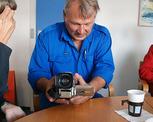 Documenting the project at Basta.
Documenting the project at Basta.
The exceptional about the project at Basta was that all personnel across divisions were engaged in the course of action and that the top management itself was directly engaged.
A sounder internal communication was kick-started and the long wished job rotations that now could diminish monotonous and repetitive labour was initiated during the project. Predisposition for further positive events and possibilities was established.
At this stage – before the shutting down the main production - the project was due to affect major changes at the factory. Could the barrier between the between the administrative staff and the production groups, between the management and the staff had been lifted; in general, could a sound the corporate culture be ‘re-formatted’ at the factory? In fact these potentials lay in the approaches at Basta.
During the project Basta was bought by the Dutch company AXA Stenman, who shortly after decided to move the production to The Nederland. Sad to say: all the production workers and several administrative workers faced unemployment, and the project came to a stand still. Single meting was held with both management and some of the task groups. The conclusive decision was that the employee should partake in the set up of the later exhibition.
Processes and facilitation at Basta
The earlier mentioned handing over of the facilitating roles was splendid at Basta. The artists made their authority in relation to the consultants very clear and the process was according to the overall premise. The whole day kick-off-seminar was very forceful and gave decisive support to the following processes. The allocated weekly hours for all personnel were very important. The scope of the projects was the everyday life at Basta and the tryout of the approach of N55 was very concrete.
Basta Ltd. (Korsoer Denmark, 2001)
At the time of the project Basta was producing locks for bicycles, and additional marketing locks and lamps for bicycles. During the project the total of staff was around 70. Shortly after the outsourcing of the production to The Nederland 16 office workers and 15 production workers (mostly working in packaging) was employed at Basta, Korsoer.
The specific role of Joachim Hamou in the project
Joachim Hamou was invited to follow the process closely. With a participatory and process evaluating approach Joachim Hamou produced several videos, including material from a range of group interviews with leaders and employees and with other selected project-participants. Several ‘auto-documentations’ done by the some of the employees was part of this ‘study’, that conceptually dealt with the understandings of ones own role and identity in relation to the work place. Joachims audiovisual ‘process evaluation’ played an important part in the project as testimonies for the other participant. The other artists employed this material as important support in understanding various aspects of the joint processes.
Exhibition – INDUSTRY OF VISION
[Inserts of pictures + caption]
Specific findings – general perspectives
During the project both companies was going through difficult times. At Basta production was shut down and LK was undergoing severe changes in the merging of two previous production facilities. The consultants in the project had imagined that a ‘mini-problematic’ of the both companies would be picked out and the problematic was to be looked upon and dealt with; in fact the total situation and problematic of the both companies were embraced and two very ambitious projects was attempted and worked through.
Concepts of time and work processes.
The project in general dealt with social relations, cooperation, exchange and internal communications, but the also project touched base with other aspects such as the grounding issue of ‘time’.
During eight hours a work agenda and work mode is set for you by others. If an objective seems unattainable or unsolvable when the time seems limited – should you then cast off the very objective? This is a fundamental problematic of corpotate organising that is difficult to solve and intertwined with the very ‘corporate modus operandi’.
This very problematic the employees started to think about in the project: You do not think about your domestic and other kinds of life. Or, you do, but you have solely to concentrate on your work agenda. On the conduct they bring into play in their own leisure time - or their ‘domestic modus operandi’ - could this very mode be brought into play at work also? Other concepts of ‘determination’ became visible. Some of the employees explicitly stressed that maybe you might reconsider you option more than only once - and moreover stated that maybe ‘the desirable something’ could be attained in other ways. It occurred to people that a difference lay in the concepts of time, and that this is actually a day to day problem for many employees. Ways of conceiving and modes of approach expands your concept of time – and as such, your capacity of action. Expanding the capacity of action in the ‘corporate modus operandi’ is something you hardly consider; and this fact is almost dispiriting in the outline of organisation, because you don’t know how to unravel this problematic.
Overall facilitation
In traditional development projects facilitated in ’traditional’ manner by management and/or consultants there are many implicit agendas, that have planed objectives long ahead in a future. Small and secluded problematic are picked out to be dealt with. The idea is to work on such ‘isolated’ topics in an overall pursuit for change and development.
The artists in this project worked to a much larger extend with the ‘here and now’ experiences of contextual problematic AND - at the very same time - the artists’ approach revealed the projects utopian notions of an overall change of the condition for communicative procedures and of the condition of corporate culture; hence conditions and possibilities of the employees (work) lives. The proposals of the project were not necessary contradictive to overall interest of corporate organising. Though maybe the conception of VI maybe seem exotic and concurrently need other types of educational programmes and enrolment of other capacities. Still; In the long run - this is not necessary more costly or risky than in traditional organisation of work and technology.
Industry of Vision
Participants - artists, coaches,, directors,, employees,, managers,, psychologists, researchers, shop stewards, union workers writers, etc. - in projects, exhibition and publication:
Anette Borup, Anja Dupont, Anne Mette Mølholt, Anne Mette Nielsen, Anne Pilgård, Anne Poulsen, Annete Laursen, Anni Jørgensen, Arlene Green, Beatrix Kielser, Bent Hansen, Bente Sørensen, Bente Stephansen, Bente Stephensen, Betina Kristensen, Birgit Nielsen, Birte Skjold Hansen, Bjarne Nielsen, Bjørnstjerne Christiansen, Carsten Pedersen, Charles Esche, Charlotte Jakobsen, Charlotte Sabroe, Christel Pedersen, Christine Buhl Andersen, Claudia Krogh, Connie Nielsen, Daniel Hjorth, Frank Madsen, Gitte Hansen, Hanne Bennedsen, Hanne Larsen, Hanne Ørud, Hardy Granhøj, Hasse Hansson, Helle Dahl, Helle Larsen, Helle Pedersen, Henrik Klausen, Inge Olsen, Ingvil Aarbakke, Irene Christensen, Jacob Pedersen, Jakob Fenger, Jan Larsson, Mogens Jensen, Jane Lynge, Jesper Kolind Lassen, Jesper Lassen, Jesper Coster, Jette Risom, Joachim Hamou, Jon Sørvin, Jørgen Kortnum, Jørgen Rasmussen, Julie Thunbo, Kari Didriksen, Karin Andersen, Kent Hansen, Leif Bøg, Lene Pedersen, Likian Larsen, Lis Bremild, Liselotte Simnonsen, Lone Hansen, Lone Ralsted, Lotte Darsø, Lotte Simonsen, Maja Hansen, Gitte Holm, Marianne Thorsted, Michael Frei, Nicolaj Knudsen, Noemi Katznelson, Pernille Forchhammer, Peter Madsen, Peter Saxtoft. Rosa Hansen, Poul Møller, Rasmus Nielsen, Rikke Luther, Ronald van Tienhoven, Rudi Jensen, Sophie Pucill, Susanne Adrian,Tina Christensen, Tina Rosendal, Tom Andersen, Uffe Olsen, Vinni,
and a lot of the other employees and managers that participated more or less extensive in the project, as in the video- and radio-interviews, etc.
----------------------------------------------------------------------
The text above was initiated by Kent Hansen, democratic innovation and Centre for Art and Leadership, Copenhagen Business School.
The text may have changed. You can follow the development of this text and comment it at www.oabook.org
Every text for the OA Thin Book at oabook.org are co-edited and/or reviewed by invitation.